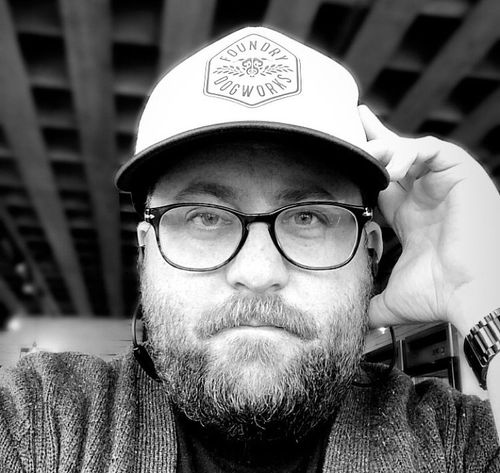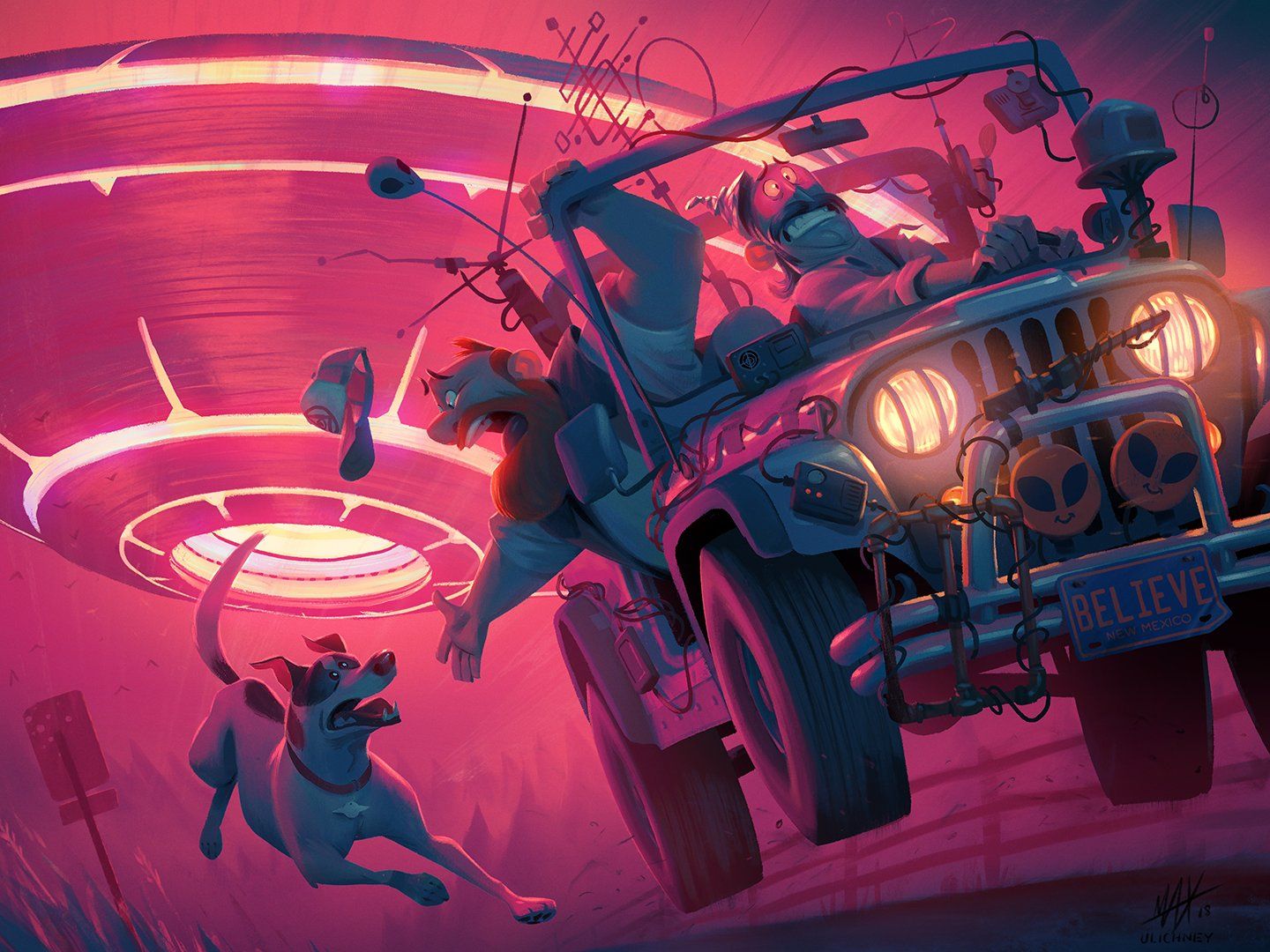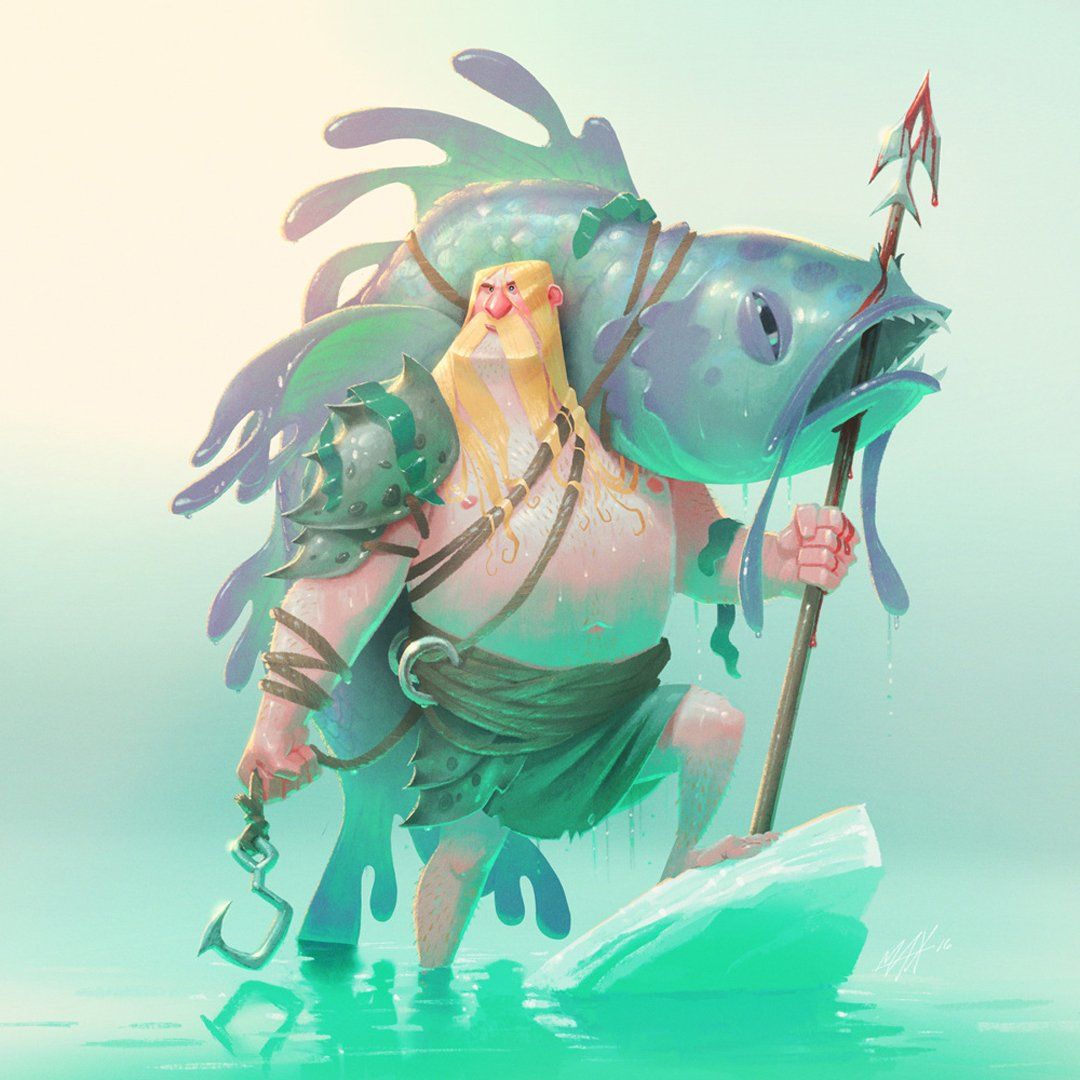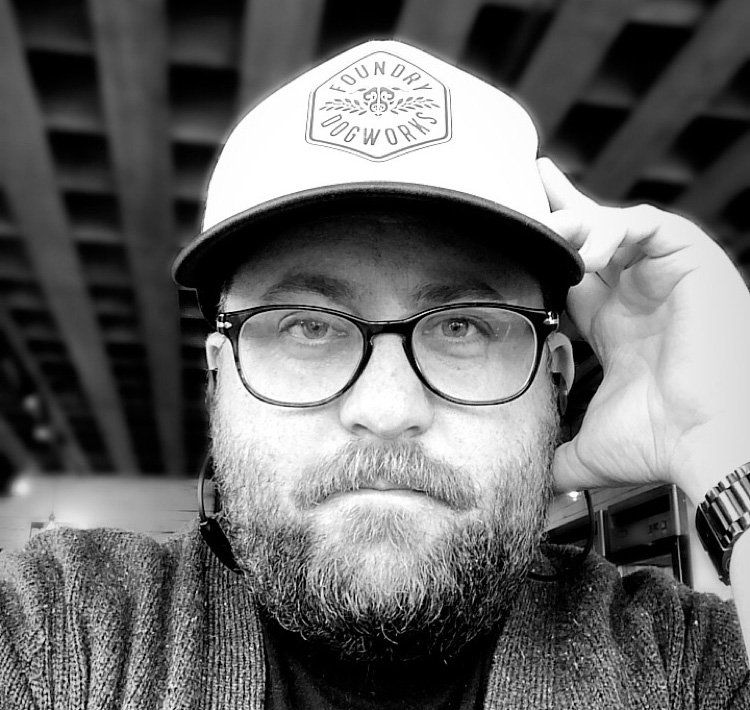
No two Max Ulichney illustrations are quite alike: he leaps from style to style with all the energy of the caricatured personalities who roam his art. Every aspect of each vibrant illustration serves the story it tells, from poses, expressions and costume designs to brushwork, color choices and background styling. Much of the liveliness of Max’s brushstrokes is down to one simple fact: he created these brushes himself.

Max shares with us his top tips for lighting, the philosophy behind the brushes he crafts, and how to rediscover long-lost creative flow.
Hey Max! Tell us a little about your illustration style and how you developed it.
I pull from my work in animation and my background in caricatures, and my love of film and comics and mid-century Cartoon Modern animation for much of my work, but for my personal work I tend to aim for more of an illustrative, painterly style than I would for concept art or production art at the studio.
I enjoy going out to cafés or parks, or otherwise people watching, and sketching the characters I observe out in the world. It’s great practice for character design, and Procreate allows me to paint wherever the people are. This is my gym, where I train and try to capture life and movement quickly, and where I can experiment with shape language and colour choices.
For my more developed illustrative work, I’m attracted to storytelling and world building. I think it’s important to have motivations for characters’ actions and their wardrobe choices, and have an implication of what might have come before and what might come after this frame. It’s sort of rare for me to just draw things because they look cool. I try to have backstories and reasons for the choices I make. The viewer may not need to know why, but hopefully they feel like these illustrations are more tangible and lived-in than something made just for aesthetic reasons.
Fantastic and dramatic lighting can be seen in a lot of your work. Have you got any tips for creating good lighting?
You can totally change the mood of a piece using only lighting, so I try to establish some idea of what I’m going for early on. I have a giant inspiration album of photos and cinematography stills that are a constant source of ideas, though I rarely copy from them directly. Sometimes it’s a misty sunrise, the slash of light across a character’s face from an old detective film, or a warm bounce of sun from the sand at the beach that catches my eye.
For my more complex lighting scenes, I find thumbnail painting to be a key stage. Balancing light and shadow will only get harder as the piece develops, so working small gives me the opportunity to audition three or four variations before I get too deep.
Compositionally, we have lots of options for dealing with lighting and helping to define the focal point of the piece. Here are the broad strategies: A light subject coming out of a dark background; dark out of light as if the subject is backlit perhaps; higher contrast out of low contrast, maybe as if emerging from fog. It can get a little more complex, but you can study any good image and see these base elements at play. This is the main thing I’m trying to solve with my thumbnails first.
Colour will work together with any of these strategies. Generally a warm subject against a cool background is a classic way to go, but you can flip that, and I often do. And sometimes I just want to paint a big crazy magenta UFO and see if I can make it work. In the case of that piece, the characters in the foreground were dark and cool against a warm light background. So although the lighting is aggressive, the foundations are pretty simple. I did experiment with different UFO lighting colors, prioritizing unnatural colors for the sake of the narrative and making a bold, playful image.

You’ve also got a lot of experience with CG production and animation. What made you want to work in this field and how have these skills helped you grow as a 2D artist?
At various points in my early artistic life I wanted to work in many different fields. Film was an early interest, and I wanted to do monster makeup and miniatures, and later Jurassic Park was the film that opened up my interest to CG. That art book was incredibly important to me. It showed me how the intersection of art and technology can be transformative and innovative. Toy Story came out shortly after that and I felt a calling that I would come back to eventually in art school. But at other times I wanted to be a comic book artist and a car designer too. My interests were always broad. At some point I realized that all of those elements that I enjoyed could be practiced by working in CG.
My career has been in CG, but my role in it quickly transitioned from modeling and lighting into art direction and character design and painting concept art for the jobs we worked on. The three dimensional understanding of creating production worthy characters is hopefully evident in the way I turn a form in my paintings. And my interest and study of cinematography that initially was for use mainly in Maya scenes elevated my ability to cast light on a character and know where the shadows would fall. It was a feedback loop that made me better at both disciplines. Now when I paint concept art, I’m able to predictably translate those aspects of a bit of a style frame into the production piece without too much undue drama.
A lot of your art is done in Procreate (which is so exciting to us), and of course you use your own brushes which you also sell. How did you get into brush making and what inspires you to create these tools?
My first brush was a pencil. I was trying to replicate a specific effect that the built in brushes, as good as they are, weren’t giving me. But I could see the potential with the excellent brush engine, and within the first night of playing with my new iPad Pro and Apple Pencil, I had set to creating this brush that would become the 2B Pencil from my Essential MaxPack. I was simply goofing around and making brushes as I worked, with no plan to sell them. But I kept getting questions about the brushes I was using and if I would sell them. I eventually gave in and developed my first two packs and launched on January 1st, 2018. The launch was far more successful than I ever expected, putting me at the centre of a new community of Procreate artists.
My Comics MaxPack came from my interest in comic books, but also from my desire to have my pencil case tools in Procreate. My sketchbook tools are a variety of Japanese pens and brushes, tech pens, mechanical pencils, markers, gel pens, and colored pencils. So everything I use in real life I can now use in Procreate.
My philosophy behind my brushes is to keep the packs focused but flexible. I prefer not to switch brushes endlessly. I don’t like being taken out of my creative flow to open up menus, so to help facilitate that I try to make brushes with the ability to make a wide range of realistic and intuitive marks when varied with pressure and tilt and speed. I love the way the Procreate interface disappears when you don’t need it, and I try to build my brushes to support that. It’s my goal to streamline the creative process and act as a counter to what I feel when I paint in the usual bloated and overstuffed desktop painting apps.
Following that, you’ve just released your long-awaited Gouache MaxPack. How’s the response been to it, and do you have any future brush packs planned that you can tell us about?I’m thrilled to say that this has been my biggest launch by far. Gouache is a very popular medium in the animation and illustration fields traditionally, but it is such a tricky medium to replicate because it’s got so much range and everyone uses it differently. I knew this would be a flagship product before I began, so I approached it very seriously. They were in development for almost a year, and I’d like to think it shows in the final product. I can say without hesitation they’re my best brushes to date and I’m happy to say the community seems to agree.
For now I’m going to take a little break and paint for fun again. Developing brushes while trying to paint for myself is hard. It takes a lot out of me, and the two goals kind of interrupt the flow of each other. That said, I learned some fun tricks when building the thin, washy gouache brushes in the new pack. I wouldn’t be surprised to see a watercolor set in the future.
On Procreate, what’s your favorite tool and what’s your dream tool?I am in love with the smudge tool. It might be the best I’ve ever used. It’s so fast and smooth. I have my finger touch mapped to be the smudge tool rather than finger painting by default. It replicates how I work in traditional charcoal where I make a mark with the charcoal stick or pencil and smudge with my fingers. It’s so intuitive and I get to preserve my years of muscle memory. Having a complementary brush in the smudge tool slot further aids my desire to reduce brush switching and interface time. I can paint with a fairly subtle smooth gouache brush, but have an aggressive, textural smudge brush at the ready to break up the edges or blend a transition with a bit of extra energy and gusto.
My dream tool would be adjustment layers. I have a few light workarounds to get me part of the way there to add contrast and finishing touches to a painting, but I would freak out if they were added to Procreate.

We’ve seen that you attend a few expos every now and then. What do you like about expos and do you recommend attending them to artists who may be looking for more visibility?
I had a great time at my first and I’m looking forward to doing more. Different expos have unique flavors, some are great for exposure and networking, and others are better for people looking to sell prints and merchandise. I recommend doing a bit of research to find one that maps better to what you’re looking to get out of it. I think conventions might potentially be the perfect place to get discovered by a like-minded audience. That said, it can be hard to stand out from the crowd, and it’s not easy to watch people pass by your booth. But you don’t have to appeal to everyone. You want to connect with the people who get you. It was truly inspiring to meet and talk to people who enjoyed my work and use my brushes.
In my experience, my favorite part about tabling was meeting the other artists who were also exhibiting. It was lovely to find a welcoming group of artists who had previously been mostly just art I would scroll past on my phone. It helped connect me to those people in a real human way.
Where do you get your ideas and inspiration from?
One of my primary sources of inspiration is going to sketch out in the world, most often cafés, but sometimes pubs, parks, trains, and more. I love to start with people with interesting features and push the shapes and proportions and see where it takes me. Or sometimes it’s someone’s posture, the way they slump while standing in line, or how they’re intensely staring at their phone as if something is wrong, or how a couple might lean toward each other. Body language is forever interesting to me. These sketches are often the basis for characters that might turn up in other scenarios.
For my illustrations, I try lots of different things. I have a large inspiration gallery of cool unrelated imagery. It’s sort of a visual treasure trove of moods and subjects. Scrolling through that when I’m stuck is a great way to spur an idea or remind me of something else I’d been thinking of in the shower or something. I also have some good storytelling podcasts that I like to listen to while working. Lore and Last Podcast on the Left are a couple of my favorites. Sometimes when I’m really drawing a blank I try free association tricks, where I just start writing a couple words or ideas from a genre I might be interested in and then see what comes to mind, and follow that whatever direction that might take me. Once I get started I can come up with a few weird ideas that I can develop. I also recently found a book title generator that gave me lots of good ideas that I wrote down for use later. I do try to keep a list of ideas to come back to.
On a deeper level I think travel and real life experience is my favorite way to come up with ideas. Being exposed to new places and adventures flips your brain into a more receptive and open mindset. I still pull from ideas I had on trips to Japan and Europe from years ago but I also like going on hikes or to the zoo to keep things fresh.

Do you have any advice for aspiring artists?
I think the best advice I got recently was from a book on creativity. It spoke about the value of habituation, which is just a fancy way of saying draw often. Make a habit of it.
People have busy lives, and at the end of the day after school or work or a long day, it’s hard to sit down and draw. So they might go months without making something for themselves. When they finally sit down to make something, they have these grand plans, and the moment is loaded with meaning and anticipation and a desire to make something great, but now they’re rusty and they struggle with their drawing and this big moment becomes disappointing and frustrating. So they don’t try again for a few months again, and now it’s even harder because they have the bad taste in their mouths from last time.
That was my problem for years. I went years without making much art for myself because of it. I ended up finding a daily hashtag art topic on Twitter. I made a habit of doing a sketch at least once a week. It was hard at first. My work was clunky and I didn’t love what I was making, but it felt easier every week and over time I found myself more likely to pick up my sketchbook as it got less intimidating. Before long I stopped using that hashtag as my ideas started to flow more easily and I had a continuity of thoughts from one drawing to the next. This is the period that led to me developing my style. I experimented a lot early on in this period and it wasn’t always successful. But that’s fine because that one sketch didn’t mean that much to me. It was a stepping stone to the next one. That initial feeling of each drawing being important faded. There was the occasional bright spot and the successes stuck with me, but the failures didn’t hurt as much. Now when I made something that I liked, I had an idea to explore further, and my failure was now a challenge I could try and overcome. I think overall what I found is that I was able to gain some objectivity on my work as a whole, and not put my entire subjective self-worth into a single piece.
Procreate actually played a big part in this process for me. When I’m at my desk, I feel much more analytical and cerebral. There’s something about having my iPad handy at any moment, on the sofa while watching TV or out enjoying the sun, that makes me approach drawing easily and quickly now. If a sketch develops into something interesting, I can take it to finish with no delay.
Meet Max’s quirky characters on his Instagram, Procreate Portfolio, or website.